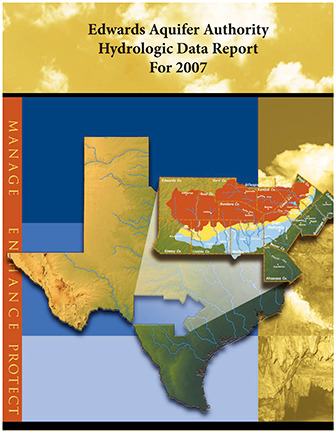Edwards Aquifer Authority Hydrologic Data Report for 2007

| Author | Hamilton M, Johnson S, Mireles J, Esquilin R, Burgoon C, Luevano G, Gregory D, Gloyd R, Sterzenback J, Mendoza R, and Schindel GM |
| Year | 2008 |
| Description | Annual report for 2007 on recharge, discharge, water levels and water quality in the Edwards Aquifer San Antonio Region |
| Report Number | 08-02 |
| Publisher | Edwards Aquifer Authority |
| Location | Edwards Aquifer - San Antonio Area |
| Cover | View Download |
| File | View Download |
| Summary |
|
(Excerpted from the report Summary) This report presents the results of the Authority’s Edwards Aquifer Data Collection Program for calendar year 2007. … Except for a few brief periods early in the year, water levels at the Bexar County (J-17) index well were significantly above the historical mean during calendar year 2007. Other wells in the region exhibited similar behavior. … Precipitation in the Edwards Aquifer region was above the mean in 2007. …Total recharge to the Edwards Aquifer was very high at 2,162,300 acre-feet in 2007, or approximately 369 percent above the median. …In calendar year 2007, groundwater discharge from the Edwards Aquifer through wells and springs totaled 917,900 acre-feet. This amount is approximately 132 percent above the median. … For well water samples collected in 2007, strontium was detected at three locations in the freshwater part of the aquifer and at five locations in the saline zone above the 15,000 μg/L MCL. Other metals detected include iron at one location above the secondary standard. Surface and spring water sample.analyses indicated the presence of mercury at two spring groups above the 2.0 μg/L MCL. Mercury was also detected at two other spring groups at concentrations below the MCL. For samples collected in 2007, bacteria concentrations indicated a wet year. Raw groundwater bacteria results from wells ranged from less than two CFU/100 mL to 13 CFU/100 mL for fecal coliform, and from less than two to 520 CFU/100 mL for fecal streptococcus. With five wells testing positive for fecal coliform and 11 wells testing positive for fecal streptococcus, two of the wells in the totals above were positive for fecal coliform and fecal streptococcus. Surface and spring water samples also indicated bacteria counts indicative of a wet year. Surface water bacteria ranged from two CFU/100 mL through TNTC for fecal coliform, and from less than two CFU/100 mL through TNTC for fecal streptococcus. Spring water samples for bacteria ranged from less than two through 140 CFU/100 mL for fecal coliform, and from less than two through 73 CFU/100 mL for fecal streptococcus. Two of the wells in the totals above were positive for fecal coliform and fecal streptococcus. For samples collected in 2007, nitrate-nitrite as nitrogen concentrations ranged from below the laboratory reporting limit of 0.015 mg/L to 10.50 mg/L in samples from wells, streams, and springs in the Edwards Aquifer region. … No VOCs were detected in the 48 wells sampled. The compounds 1,3,5-trimethylbenzene, toluene, 1,2,4-trimethylbenzene, m,p-xylene, and naphthalene were detected in spring water samples at concentrations well below their respective MCL and PCL values…. No SVOCs were detected in well samples; however, the compounds phenol and 2-methylnaphthalene were detected in spring water samples in 2007 at concentrations well below the PCL values….No sample tested positive for [herbicides, pesticides, and PCBs]. Edwards Aquifer water is generally of such high quality that it normally requires only chlorination to meet public drinking water standards. However, detection of nitrates and organic compounds, as well as trace quantities of metals such as mercury, in the aquifer is a concern, and the Authority will continue to monitor for these compounds to determine possible sources and trends. … Confirmed detections of anthropogenic compounds such as VOC and SVOC detections at the springs are a concern and warrant continued monitoring in the future. The Authority’s aquifer-wide water-quality sampling program will continue to monitor wells, streams, and springs for indications of water-quality impacts throughout the region. In addition to routine samples collected from wells, streams, and springs in 2007, the Authority analyzed more than 3,000 fluorescence samples from 90 wells during the year in response to the Helotes debris fire. The fire was located primarily over the recharge zone of the aquifer and burned from the end of December 2006 until late March 2007. … [S]ome residential wells in close proximity to the fire were impacted by leachate and/or runoff water from fire-fighting activities. This information resulted in development of a unique fire-fighting plan to prevent further impacts to the aquifer, which included regular collection of samples from wells within a two-mile radius of the fire and screening these samples for indicators associated with fire-fighting activities. One of the screening parameters was analyses of samples for organic acids using the Authority’s Perkin Elmer LS-50B Luminescence Spectrometer. Regular monitoring, combined with a well-developed plan to limit runoff water, appears to have prevented significant widespread contamination of the aquifer. |
Search for Documents
Advance Search
Explore EAA's Scientific Reports
- All Reports
- Weather Modification
- Geology
- Water Use and Conservation
- Geochemistry
- Water Resources Planning and Management
- Floods and Drought
- Water Quality
- Climatology
- Surface Water / Groundwater Relationship
- Biology
- Springs, Groundwater Discharge
- Archaeology
- RZ Protection
- Aquifer Levels
- Remote Sensing
- Precipitation
- Overview Studies
- Modeling
- Hydrology and Hydrogeology
- History
- Groundwater Recharge, Recharge Zone
- Groundwater Movement
- Geomorphology and Caves
